If you’re a gardener, you know that having the right tools is essential to get the job done efficiently and effectively. When it comes to cutting tasks, there are two main types of tools: chainsaws and traditional tools. Chainsaws are powerful and efficient, but they can also be dangerous if not used properly. Traditional tools, on the other hand, may not be as powerful but are generally safer to use. In this article, we’ll explore the pros and cons of chainsaws versus traditional tools in gardening.
Understanding chainsaws is crucial if you’re considering using one in your gardening tasks. Chainsaws are motorized saws that use a chain and bar to cut through wood. They come in various sizes and types, including gas-powered, electric, and battery-powered models. Chainsaws are ideal for cutting down trees, trimming branches, and other heavy-duty tasks. However, they can also be noisy, heavy, and require more maintenance than traditional tools.
Traditional gardening tools, such as hand saws, loppers, and pruning shears, are generally safer to use than chainsaws. They require less maintenance, are quieter, and are often less expensive. However, traditional tools may not be as efficient as chainsaws in cutting tasks, especially for larger trees and branches. In the next sections, we’ll explore the pros and cons of chainsaws and traditional tools in more detail.
Key Takeaways
- Chainsaws are powerful and efficient, but they can also be dangerous if not used properly.
- Traditional tools are generally safer to use and require less maintenance, but they may not be as efficient in cutting tasks.
- Choosing the right tools for your gardening tasks depends on several factors, including physical and environmental impact, cost, and value considerations.
Table of Contents
Understanding Chainsaws
If you’re planning to take on some serious gardening or landscaping, a chainsaw can be a valuable tool to have in your arsenal. Chainsaws are powerful and versatile, and they can make quick work of even the toughest jobs. In this section, we’ll take a closer look at chainsaws and how they work.
Types of Chainsaws
There are several types of chainsaws available on the market, each with their own unique features and benefits. Here are some of the most common types of chainsaws:
Gas-powered chainsaws: These chainsaws are powered by gasoline and are typically the most powerful type of chainsaw available. They are ideal for heavy-duty tasks and can handle large logs and trees with ease.
Electric chainsaws: Electric chainsaws are powered by electricity and are generally less powerful than gas-powered chainsaws. However, they are quieter and easier to maintain, making them a good choice for smaller jobs.
Battery-powered chainsaws: Battery-powered chainsaws are cordless and are powered by rechargeable batteries. They are lightweight and portable, making them a good choice for jobs that require mobility.
Corded chainsaws: Corded chainsaws are powered by electricity and are attached to a power source via a cord. They are generally less powerful than gas-powered chainsaws, but they are also quieter and easier to maintain.
How Chainsaws Work
Chainsaws work by using a chain that is wrapped around a guide bar. The chain is powered by a motor, which rotates the chain around the guide bar at high speeds. The sharp teeth on the chain cut through wood, making it easy to cut through even the toughest logs and trees.
Chainsaws come with a variety of safety features to help prevent accidents. For example, most chainsaws have a chain brake that stops the chain from rotating if the saw kicks back. They also have a throttle lock that prevents the saw from accidentally turning on.
When using a chainsaw, it’s important to wear the proper safety gear, including eye and ear protection, gloves, and sturdy footwear. You should also be familiar with the saw’s controls and safety features before using it.
Overall, chainsaws are a powerful and versatile tool that can make gardening and landscaping tasks much easier. By understanding the different types of chainsaws and how they work, you can choose the right tool for the job and use it safely and effectively.
Traditional Gardening Tools
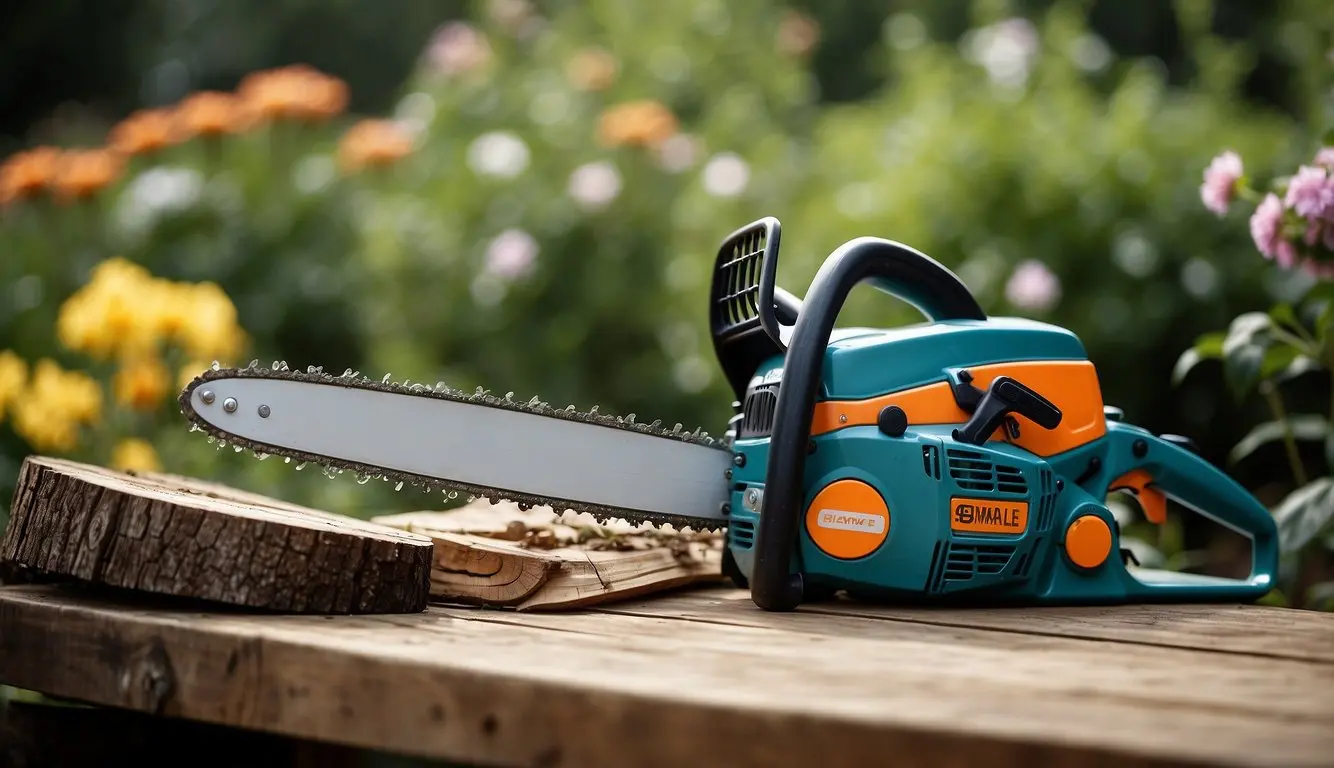
When it comes to traditional gardening tools, there are many options available. Some of the most common tools include shovels, hoes, rakes, and trowels. These manual tools are designed to help you plant, cultivate, and harvest your garden.
Manual Tools Overview
Manual tools are an essential part of any gardener’s toolkit. They are versatile, durable, and easy to use. Whether you are planting seeds, digging up weeds, or harvesting your crops, manual tools can help you get the job done quickly and efficiently.
There are many different types of manual tools available, each with its own unique features and benefits. For example, shovels are great for digging holes and moving soil, while hoes are ideal for cutting through weeds and cultivating the soil. Rakes are perfect for smoothing out soil and removing debris, while trowels are great for planting small seeds and bulbs.
Tool Maintenance
To keep your manual tools in good working order, it’s important to take care of them properly. This includes regular cleaning and maintenance. After each use, wipe down your tools with a damp cloth to remove any dirt or debris. If your tools become particularly dirty, you may need to use soap and water to clean them.
In addition to cleaning, it’s important to regularly inspect your tools for signs of wear and tear. Check for cracks, rust, and other damage that could affect the performance of your tools. If you notice any issues, it’s best to replace your tools as soon as possible to avoid further damage.
Overall, manual gardening tools are a reliable and effective option for any gardener. With proper care and maintenance, they can last for many years and help you create a beautiful and productive garden.
Safety Considerations
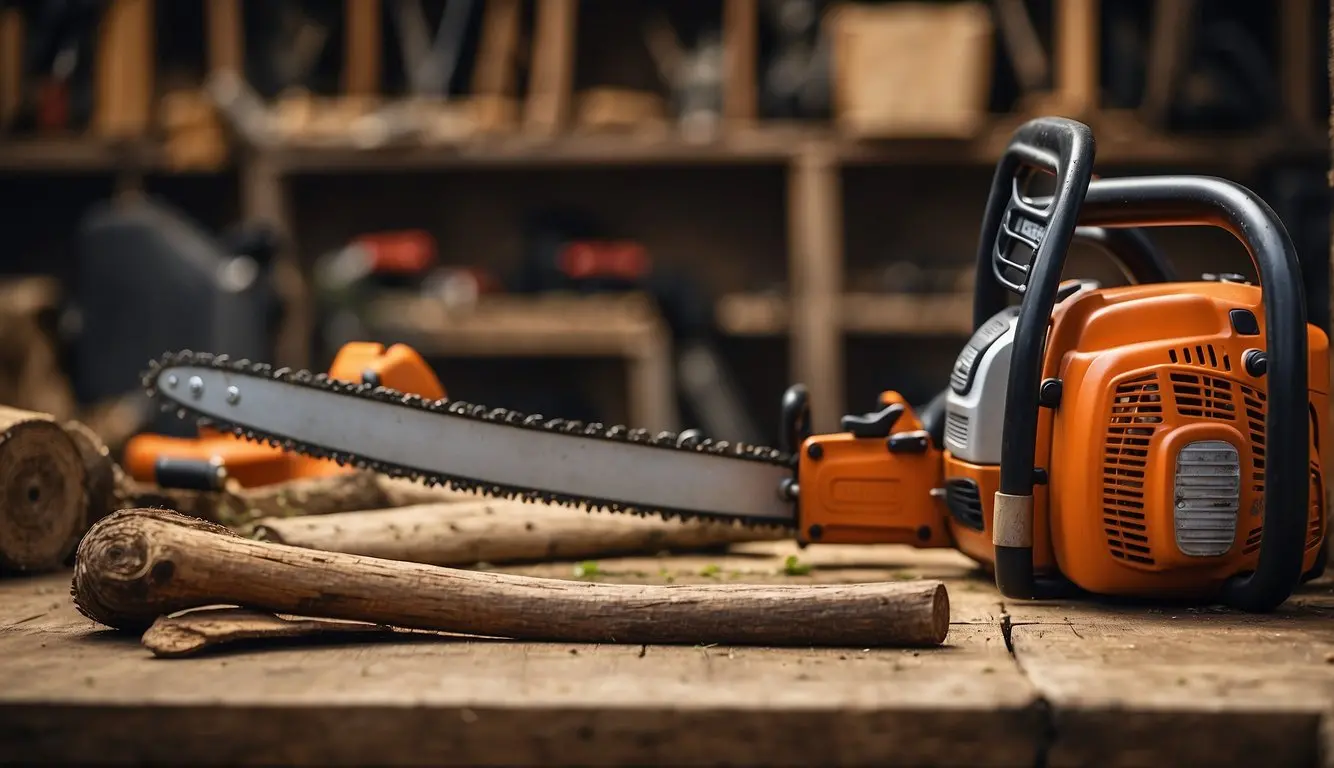
When it comes to using power tools like chainsaws, safety should always be a top priority. Here are some key safety considerations to keep in mind when using a chainsaw or traditional gardening tools:
Chainsaw Safety Features
Most modern chainsaws come with a variety of safety features designed to reduce the risk of injury. Some of the most common safety features include:
- Chain brakes: These are designed to stop the chainsaw chain from rotating in the event of kickback or other sudden movements.
- Anti-vibration systems: These help reduce the amount of vibration that the operator feels, which can help reduce fatigue and strain.
- Throttle interlock: This feature requires the operator to engage the throttle lock before starting the chainsaw, which can help prevent accidental starts.
- Safety switches: These are designed to prevent the chainsaw from accidentally starting.
Safe Tool Handling Practices
In addition to safety features, there are a number of safe tool handling practices that can help reduce the risk of injury when using a chainsaw or other gardening tools. Here are a few key tips:
- Wear protective gear: Always wear gloves, eye protection, and other appropriate safety gear when using a chainsaw or other power tools.
- Be aware of kickback: Kickback is a common cause of chainsaw-related injuries. Always keep the chainsaw away from your body and be aware of the potential for kickback when cutting.
- Follow safety precautions: Always follow the manufacturer’s safety precautions when using a chainsaw or other power tools. This may include instructions on how to start and stop the tool, how to hold it properly, and how to maintain it.
- Keep the tool in good condition: Regular maintenance can help keep your chainsaw or other gardening tools in good condition, which can help reduce the risk of accidents and injuries.
By following these safety considerations and using common sense, you can help reduce the risk of injury when using a chainsaw or other gardening tools.
Efficiency in Cutting Tasks
When it comes to cutting tasks in gardening, using the right tool can make a significant difference in your efficiency. Chainsaws and traditional tools each have their pros and cons, and understanding them can help you choose the right tool for the job.
Speed and Precision
Chainsaws are designed for heavy-duty cutting tasks and are ideal for cutting through thick timber quickly. They are especially useful for tasks that require speed over precision, such as felling trees or cutting large branches. On the other hand, traditional tools like handsaws and pruning saws offer greater precision, making them ideal for delicate cutting tasks that require accuracy and control.
Energy and Labor
Chainsaws are powered by gas or electricity, which makes them more energy-efficient than traditional tools that rely on manual labor. This means that you can get more work done in less time with a chainsaw, and you won’t tire out as quickly. However, chainsaws can be heavy and require more physical effort to operate, which can be a disadvantage for some users. Traditional tools are lightweight and easy to handle, making them an excellent choice for users who prefer a less physically demanding option.
In summary, when it comes to efficiency in cutting tasks in gardening, chainsaws are ideal for heavy-duty cutting tasks that require speed over precision, while traditional tools are better suited for delicate cutting tasks that require accuracy and control. Chainsaws are more energy-efficient, but they require more physical effort to operate, while traditional tools are lightweight and easy to handle.
Pros and Cons of Chainsaws

Chainsaws are powerful tools that can make gardening tasks easier and more efficient. However, they also have limitations that you should consider before using them. Here are the advantages and limitations of using chainsaws in gardening:
Advantages of Chainsaws
Powerful: Chainsaws are powerful tools that can cut through wood quickly and easily. They are ideal for cutting down trees, pruning branches, and cutting firewood.
Speed: Chainsaws can cut through wood much faster than traditional tools like handsaws and axes. This can save you a lot of time and effort, especially if you have a lot of wood to cut.
Portability: Many chainsaws are lightweight and easy to carry, making them ideal for use in remote areas or on uneven terrain.
Efficiency: Chainsaws are more efficient than traditional tools because they require less effort to use. This means that you can get more work done in less time.
Limitations of Chainsaws
Noise: Chainsaws are noisy tools that can be disruptive to your neighbors and anyone else in the area. You should always wear ear protection when using a chainsaw to protect your hearing.
Emissions: Some chainsaws emit harmful fumes that can be hazardous to your health and the environment. You should always use a chainsaw that meets emissions standards in your area.
Limitations: Chainsaws are not suitable for all gardening tasks. They are best used for cutting down trees, pruning branches, and cutting firewood. They are not ideal for tasks that require precision or delicate cutting.
Safety: Chainsaws can be dangerous tools if not used properly. You should always read the manufacturer’s instructions and wear protective gear when using a chainsaw.
Pros and Cons of Traditional Tools
When it comes to gardening, traditional tools have been used for centuries to maintain and cultivate gardens. These tools are manually operated and do not require any power source. They are versatile, durable, and affordable. However, they also have some drawbacks that you should consider before choosing them over chainsaws or other power tools.
Benefits of Manual Tools
Manual tools have several benefits that make them a preferred choice for many gardeners. Some of these benefits include:
Versatility: Manual tools are versatile and can be used for various gardening tasks, such as digging, planting, weeding, pruning, and harvesting. They are suitable for both small and large gardens and can be used in tight spaces where power tools cannot reach.
Reach: Manual tools come in different sizes and shapes, making it easy to reach plants and areas that are difficult to access. For example, a hand pruner can be used to trim small branches and stems, while a lopper can be used to cut thicker branches.
Precision: Manual tools offer more precision than power tools, allowing you to make accurate cuts and trimmings. This is especially important when working with delicate plants or when shaping topiaries.
Drawbacks of Manual Tools
While manual tools have many benefits, they also have some drawbacks that you should be aware of. Some of these drawbacks include:
Limitations: Manual tools have limitations when it comes to cutting thicker branches or working on larger areas. They require more time and effort to use, which can be tiring and time-consuming.
Physical strain: Using manual tools can be physically demanding, especially if you have a large garden or if you need to use them for an extended period. This can lead to fatigue, muscle strain, and even injuries.
Maintenance: Manual tools require regular maintenance to keep them in good condition. You need to sharpen the blades, oil the moving parts, and clean them after use. This can be time-consuming and requires some skill and knowledge.
- In conclusion, traditional tools have their pros and cons when it comes to gardening. While they offer versatility, reach, and precision, they also have limitations, physical strain, and maintenance requirements. Consider your gardening needs and preferences before choosing between manual tools and power tools like chainsaws.
Gardening Tasks and Tool Suitability
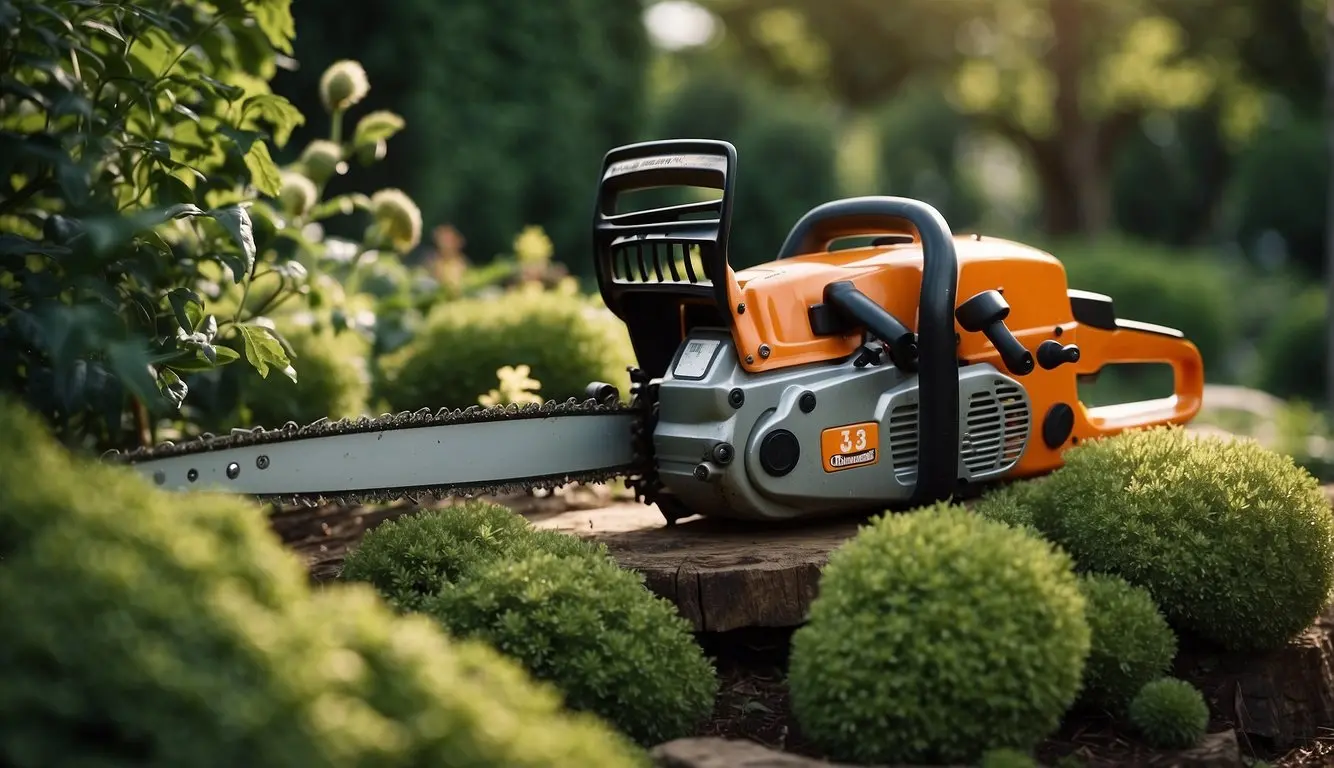
When it comes to gardening tasks, different tools are suitable for different jobs. Here, we will discuss the suitability of chainsaws and traditional tools for two common gardening tasks: pruning and trimming, and felling trees and cutting firewood.
Pruning and Trimming
Pruning and trimming are essential gardening tasks that help maintain the health and shape of trees and shrubs. Traditional tools such as hand pruners, loppers, and pruning saws are suitable for small pruning jobs such as removing small branches and twigs. These tools are lightweight, easy to use, and allow for precision cutting.
However, for larger pruning tasks such as removing thick branches, a chainsaw may be more suitable. Chainsaws are powerful tools that can make quick work of large branches. They are also useful for trimming trees and shrubs that are too tall to reach with traditional tools.
Felling Trees and Cutting Firewood
Felling trees and cutting firewood are more demanding gardening tasks that require more powerful tools. Chainsaws are the go-to tool for felling trees and cutting firewood. They are powerful, efficient, and can cut through thick logs quickly.
However, if you only need to cut a small amount of firewood or trim a few branches, traditional tools such as hand saws and axes may be more suitable. These tools require more effort and time to use, but they are quieter, cheaper, and do not require fuel or electricity.
In summary, when it comes to gardening tasks, the suitability of chainsaws and traditional tools depends on the job at hand. For small pruning jobs and trimming tasks, traditional tools are suitable and more precise. For larger pruning jobs, felling trees, and cutting firewood, chainsaws are more efficient and powerful.
Physical and Environmental Impact
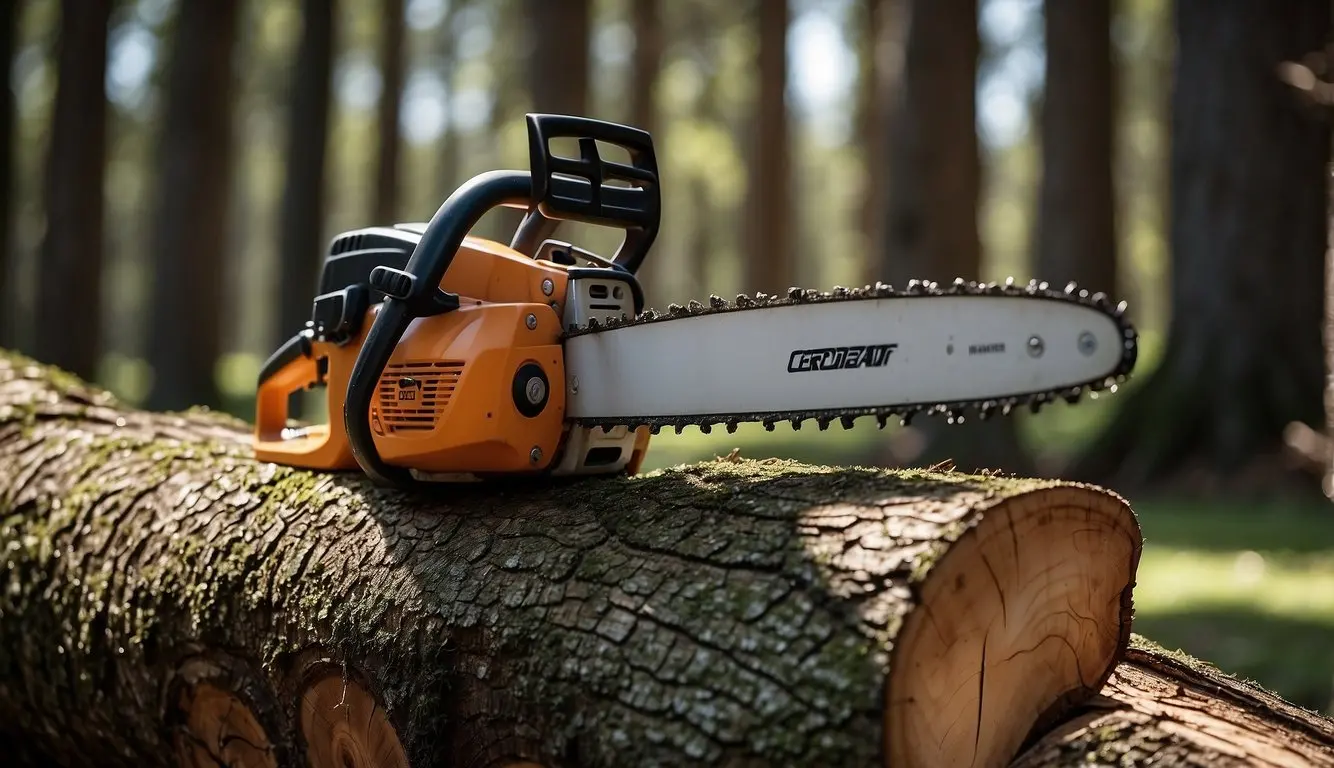
When it comes to gardening tools, the physical and environmental impact is an important factor to consider. In this section, we will discuss the impact of chainsaws and traditional tools on weight, ergonomics, noise, emissions, and vibration.
Tool Weight and Ergonomics
Chainsaws are generally heavier than traditional tools, which can make them more difficult to maneuver for extended periods of time. However, modern chainsaws are designed with ergonomic features such as anti-vibration systems and comfortable handles to reduce operator fatigue. Traditional tools such as hand pruners and loppers are lighter and easier to handle, but they require more physical effort to use.
Noise and Emissions
Chainsaws are known for their loud noise and emissions, which can be harmful to both the operator and the environment. Gas-powered chainsaws produce more emissions than electric chainsaws, which are quieter and produce fewer emissions. Traditional tools such as hand pruners and loppers produce no emissions and are much quieter than chainsaws. When choosing a tool, consider the noise and emissions it produces and how it will affect the environment and those around you.
In summary, when choosing between a chainsaw and traditional tools for gardening, it is important to consider the physical and environmental impact of each tool. Chainsaws are heavier and produce more noise and emissions, but they are designed with ergonomic features to reduce operator fatigue. Traditional tools are lighter and quieter, but they require more physical effort to use. Ultimately, the choice depends on your personal preference and the specific needs of your gardening project.
Cost and Value Considerations
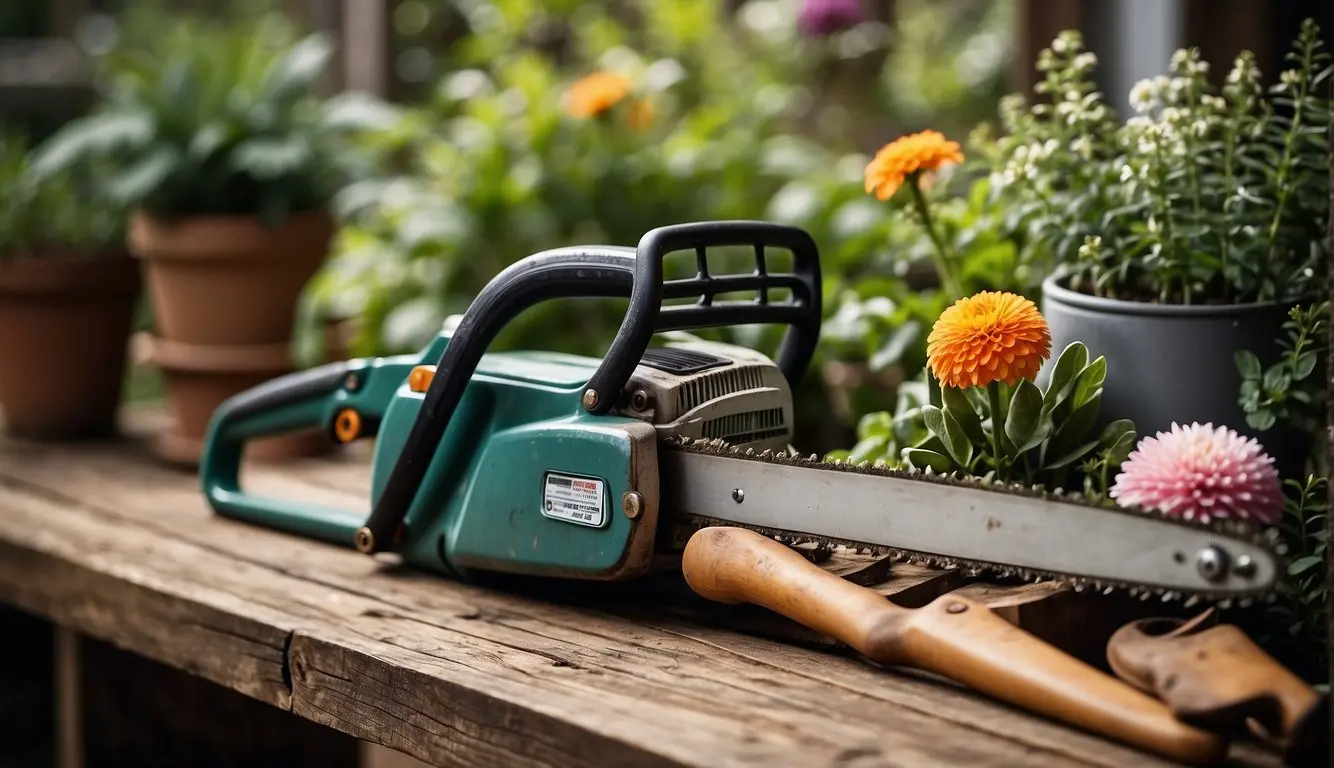
When deciding between a chainsaw and traditional gardening tools, cost and value are important considerations. In this section, we’ll examine the initial investment and long-term value of both options.
Initial Investment
The initial cost of a chainsaw can be higher than that of traditional tools such as hand saws or pruning shears. However, chainsaws come in a wide range of prices, from budget-friendly options to professional-grade models. It’s important to consider your gardening needs and budget when choosing a chainsaw.
Traditional tools may have a lower initial cost, but keep in mind that you may need to purchase multiple tools to complete certain tasks. For example, a hand saw may work for small branches, but a chainsaw may be necessary for larger trees. It’s important to weigh the initial cost against the long-term value and performance of the tool.
Long-Term Value
When it comes to long-term value, chainsaws can offer several benefits. They are often faster and more efficient than traditional tools, allowing you to complete tasks more quickly. Additionally, many chainsaws come with warranties and are built to last, providing reliable performance for years to come.
Traditional tools, on the other hand, may require more maintenance and replacement over time. Hand saws may become dull and need to be sharpened or replaced, while pruning shears may need to be oiled and cleaned regularly. However, traditional tools can offer a more hands-on approach to gardening and may be preferred by those who enjoy the process.
Ultimately, the decision between a chainsaw and traditional tools comes down to your individual needs and preferences. By considering the initial cost and long-term value of each option, you can make an informed decision that meets your gardening needs and budget.
Choosing the Right Tools for Your Needs
When it comes to gardening, having the right tools can make all the difference. While chainsaws and traditional tools both have their pros and cons, choosing the right tool for each task is crucial. In this section, we’ll explore how to assess your gardening needs and match tools to tasks.
Assessing Gardening Needs
Before you start shopping for tools, it’s important to assess your specific needs. Consider the size of your yard or garden, the types of plants you have, and the tasks you need to perform. For example, if you have a small garden with only a few trees, a hand saw might be sufficient for pruning and trimming. However, if you have a large yard with lots of trees, a chainsaw might be a better option for efficiency and speed.
Another factor to consider is your physical ability and preferences. Some people may find traditional tools like hand saws or pruning shears to be more comfortable and easier to use than a chainsaw. Others may prefer the power and speed of a chainsaw, despite its weight and noise.
Matching Tools to Tasks
Once you’ve assessed your needs and preferences, it’s time to match tools to tasks. Here are some common gardening tasks and the tools that are best suited for them:
- Pruning and trimming small branches and shrubs: Hand pruners or pruning shears
- Pruning and trimming larger branches and trees: Hand saw or chainsaw
- Cutting firewood: Chainsaw
- Removing tree stumps: Chainsaw or stump grinder
- Clearing brush and undergrowth: Brush cutter or machete
It’s important to use the right tool for each task to ensure safety and efficiency. Using a chainsaw for pruning small branches can be dangerous, while using hand pruners for cutting firewood can be time-consuming and inefficient.
In conclusion, choosing the right tool for your gardening needs requires careful assessment and consideration. By matching tools to tasks and taking into account your physical ability and preferences, you can ensure that your gardening tasks are completed safely and efficiently.
Care and Storage of Tools
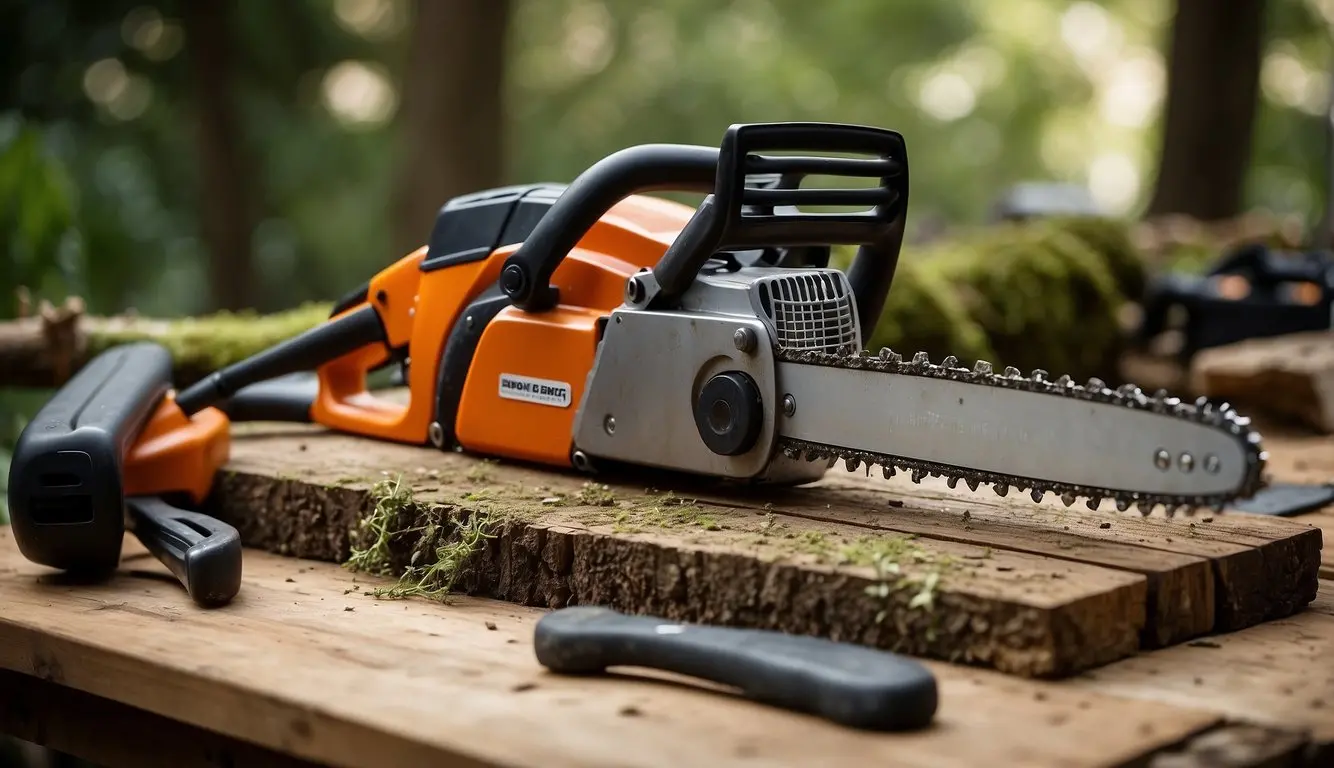
Proper Maintenance
Maintaining your gardening tools, including chainsaws and traditional tools, is essential for their longevity and performance. Proper maintenance will also ensure that your tools are safe to use.
For chainsaws, regular maintenance includes checking the chain tension, sharpening the chain, and cleaning the air filter. You should also inspect the spark plug, fuel filter, and carburetor regularly, and replace them if necessary. It is recommended to refer to the manufacturer’s manual for specific maintenance instructions.
For traditional tools, such as hand saws and pruning shears, it is important to keep them clean and sharp. Wipe down the blades after each use, and sharpen them regularly. You can use a sharpening stone or file to sharpen the blades. You should also oil the moving parts of your tools to prevent rust and corrosion.
Storing Tools Safely
Proper storage of your gardening tools is crucial to ensure their longevity and safety. You should store your tools in a dry, cool place, away from direct sunlight.
For chainsaws, it is recommended to empty the fuel tank and run the engine until it stalls before storing it. You should also remove the chain and bar, and store them separately. This will prevent the chain from becoming dull and the bar from rusting. You can also use a chainsaw case or cover to protect your chainsaw from dust and debris.
For traditional tools, you can use a tool rack or pegboard to store them. Make sure to hang them up or store them in a way that prevents the blades from touching each other. You can also use a tool chest or toolbox to store your tools. Make sure to clean them before storing them, and oil the moving parts to prevent rust and corrosion.
By following these maintenance and storage tips, you can ensure that your chainsaws and traditional tools remain in good condition, and are safe to use.
Frequently Asked Questions
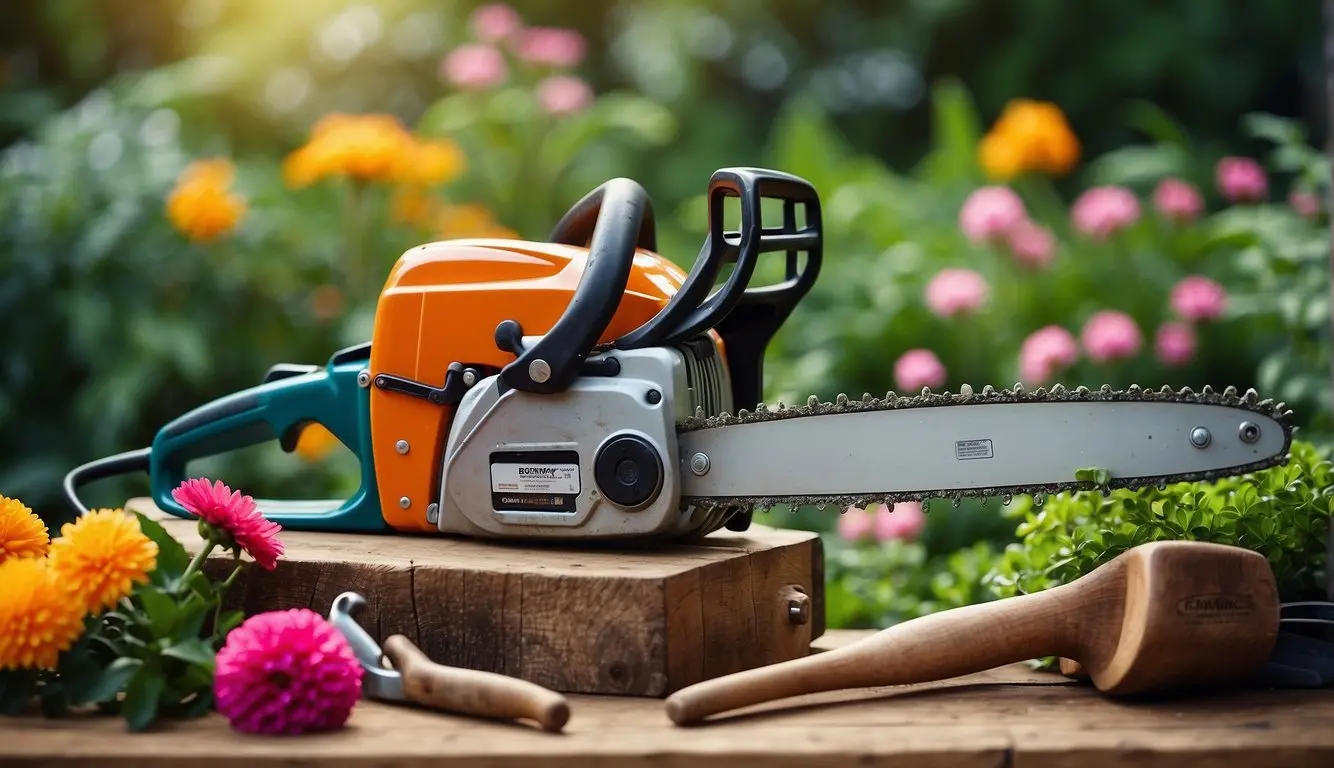
What are the advantages of using a chainsaw for garden maintenance compared to hand tools?
Using a chainsaw for garden maintenance can be advantageous as it allows you to cut through thicker branches and logs with ease. This can save you time and effort, especially when dealing with larger trees. Chainsaws are also more powerful than hand tools, which means they can be used to complete tasks more quickly. Additionally, chainsaws are versatile and can be used for a range of gardening tasks, from pruning and trimming to felling trees.
How do safety concerns differ between chainsaws and manual pruning tools?
Safety concerns differ between chainsaws and manual pruning tools. Chainsaws are powerful machines that require proper training and safety gear to use safely. It is important to wear protective clothing, including gloves, eye protection, and ear protection when using a chainsaw. Manual pruning tools, on the other hand, can be safer to use as they do not have the same level of power as chainsaws. However, it is still important to wear protective gear when using manual tools to avoid injury.
In what situations would a traditional gardening tool be preferred over a chainsaw?
Traditional gardening tools, such as hand pruners, loppers, and saws, may be preferred over chainsaws in certain situations. For example, when pruning small branches and shrubs, hand tools may be more precise and allow for greater control. Additionally, hand tools are often quieter than chainsaws, which can be important if you are working in a residential area.
What are the environmental impacts of using a chainsaw versus hand tools in gardening?
Using a chainsaw can have a greater environmental impact than using hand tools. Chainsaws are powered by gasoline or electricity, both of which have negative environmental impacts. Gasoline-powered chainsaws emit pollutants into the air and contribute to climate change. Electric chainsaws are more environmentally friendly, but still require electricity to operate, which may come from non-renewable sources. Hand tools, on the other hand, do not require any external power source and are therefore more eco-friendly.
How does the cost of ownership compare between chainsaws and traditional gardening tools?
The cost of ownership for chainsaws and traditional gardening tools can vary widely depending on the specific tools you are comparing. Chainsaws can be more expensive to purchase initially but may be more cost-effective in the long run if you have a lot of trees to maintain. Traditional gardening tools, such as hand pruners and loppers, are generally less expensive to purchase and maintain but may require more frequent replacement if used heavily.
What are the differences in time efficiency when using a chainsaw as opposed to manual tools for garden work?
Using a chainsaw can be more time-efficient than using manual tools for garden work, especially when dealing with larger branches and trees. Chainsaws are more powerful than hand tools, which means they can cut through wood more quickly. However, it is important to note that using a chainsaw requires proper training and safety gear, which can add extra time to the task. Additionally, hand tools may be more precise and allow for greater control, which can be important when working on delicate plants or shrubs.
- Best Brush Cutter: Top 5 Models for Lawn Maintenance in 2024 - January 10, 2024
- Protecting Your Garden from Rodent Damage: Tips and Tricks - December 14, 2023
- Small Space Gardening: Transform Your Garden with Raised Beds - December 10, 2023
